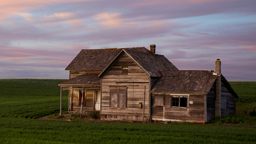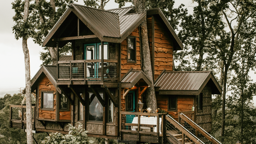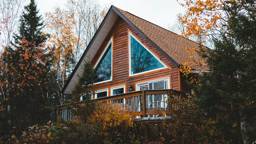When autumn approaches and daylight hours get shorter, life at the cabin often slows down in anticipation of cooler temperatures and longer nights. By September, the number of guests dwindles as friends and family return to school or work. To most cabin dwellers, it seems like outdoor maintenance should be just about over.
But reconsider that assumption, because several important tasks can be done in autumn to make life easier when spring rolls around. Don’t put away those outdoor tools just yet …
The lay of the land
Sit on your deck or in a lawn chair in the yard; look out at the view and inspect your treescape. Slowly walk all the way around the cabin. Are there shrubs that have gotten too large? A dead tree that needs to be taken down? Is your lake view compromised by foliage growing out of control? Are the bottom limbs on the big maple dead? Write down what you see as trouble areas and create a plan of attack! Fall is the perfect time to ensure that you have healthy, attractive plants that enhance your place for years to come.
Out on a limb
If you’ve got a tree with dead or diseased limbs, you’ll need to get rid of them to keep your trees healthy and to keep you safe. Eventually the leaves will wither and die and the branch with it. These branches could fall and cause injury or even property damage; they can also interrupt the sight line to an otherwise beautiful vista.
The main thing to remember when cutting is to remove the branch outside of its collar; in other words, do not cut right along the trunk. The branch collar contains trunk tissue and should not be damaged or removed. “Tree-wound” salve is not necessary if the cut is made correctly. If you’re pruning diseased limbs, you’ll want to be sure to disinfect your shears after each cut.
But reconsider that assumption, because several important tasks can be done in autumn to make life easier when spring rolls around. Don’t put away those outdoor tools just yet …
The lay of the land
Sit on your deck or in a lawn chair in the yard; look out at the view and inspect your treescape. Slowly walk all the way around the cabin. Are there shrubs that have gotten too large? A dead tree that needs to be taken down? Is your lake view compromised by foliage growing out of control? Are the bottom limbs on the big maple dead? Write down what you see as trouble areas and create a plan of attack! Fall is the perfect time to ensure that you have healthy, attractive plants that enhance your place for years to come.
Out on a limb
If you’ve got a tree with dead or diseased limbs, you’ll need to get rid of them to keep your trees healthy and to keep you safe. Eventually the leaves will wither and die and the branch with it. These branches could fall and cause injury or even property damage; they can also interrupt the sight line to an otherwise beautiful vista.
The main thing to remember when cutting is to remove the branch outside of its collar; in other words, do not cut right along the trunk. The branch collar contains trunk tissue and should not be damaged or removed. “Tree-wound” salve is not necessary if the cut is made correctly. If you’re pruning diseased limbs, you’ll want to be sure to disinfect your shears after each cut.
A good pruning
Pruning in late fall or winter is ideal for most trees, as it leaves fresh wounds exposed for only a short length of time before the wounds seal up. Additionally, if the leaves are down, it’s easier to see the branch structure and prune accordingly.
Look for branches that cross and rub against each other and remove one. The constant rubbing destroys the bark and allows disease or insects in. Also, using a good snips, remove all suckers at the base of the tree; they are unsightly and a waste of the tree’s energy. Then, to ensure good air flow to the canopy, remove branches in spots that are too densely compacted together.
Basically, trees assume their natural shape in accordance with the water, space, and sunlight they receive; this basic pruning just helps them attain their natural beauty.
Hedging your bets
Once a year you should perform a renewal pruning on your older or more overgrown hedges. To do this, cut the oldest branches all the way down to the crown of the shrub. Your shrubs will fill out and last longer.
If you cut your hedges too early in the fall, however, they’ll regrow rapidly, which may not give the new growth enough time to harden and may result in cold damage. So wait until late in fall or early winter, when you can be sure the hedge is dormant.
Perfect planting
Fall is also a good time for planting spring-blooming bulbs, such as daffodils, tulips and allium, but many cabin owners make the mistake of planting these bulbs near the foundation of the cabin. Spring-blooming bulbs are like an invitation to a banquet for mice, voles and chipmunks; when the weather gets colder, they move right into the cabin for shelter. It’s better to plants bulbs in several clusters in a woodland setting. If you must have foundation plants, hostas or even a rock garden with thorny succulents is a better choice.
Fall is also a great time for planting trees and shrubs to enhance a view, define a property line, or serve as a windbreak, backdrop or privacy screen. Selecting the proper plant for the location will cut down on future pruning. Keep an eye on the size of the mature plant, its hardiness and moisture requirements when selecting fall plantings.
Lots o’ leaves
Finally, if you have deciduous trees, consider where to put the leaves. Remove them from walkways and paths – rotting leaves are very slippery. Rake them off the lawn to encourage healthy grass in the spring, free of snow-mold. A good idea is to spread the leaves under shrubs and pile them on perennials. You can even bag them and stack them around the foundation for insulation, however this can attract mice, so do so at your own risk.
Once you have completed these tasks, then it really is time to sit back with a good book, relax and enjoy those long nights.
Michele Helbacka is an English teacher. But in the summers, she puts her green thumbs to work in her gardens on the shore of the St. Louis River.
Pruning in late fall or winter is ideal for most trees, as it leaves fresh wounds exposed for only a short length of time before the wounds seal up. Additionally, if the leaves are down, it’s easier to see the branch structure and prune accordingly.
Look for branches that cross and rub against each other and remove one. The constant rubbing destroys the bark and allows disease or insects in. Also, using a good snips, remove all suckers at the base of the tree; they are unsightly and a waste of the tree’s energy. Then, to ensure good air flow to the canopy, remove branches in spots that are too densely compacted together.
Basically, trees assume their natural shape in accordance with the water, space, and sunlight they receive; this basic pruning just helps them attain their natural beauty.
Hedging your bets
Once a year you should perform a renewal pruning on your older or more overgrown hedges. To do this, cut the oldest branches all the way down to the crown of the shrub. Your shrubs will fill out and last longer.
If you cut your hedges too early in the fall, however, they’ll regrow rapidly, which may not give the new growth enough time to harden and may result in cold damage. So wait until late in fall or early winter, when you can be sure the hedge is dormant.
Perfect planting
Fall is also a good time for planting spring-blooming bulbs, such as daffodils, tulips and allium, but many cabin owners make the mistake of planting these bulbs near the foundation of the cabin. Spring-blooming bulbs are like an invitation to a banquet for mice, voles and chipmunks; when the weather gets colder, they move right into the cabin for shelter. It’s better to plants bulbs in several clusters in a woodland setting. If you must have foundation plants, hostas or even a rock garden with thorny succulents is a better choice.
Fall is also a great time for planting trees and shrubs to enhance a view, define a property line, or serve as a windbreak, backdrop or privacy screen. Selecting the proper plant for the location will cut down on future pruning. Keep an eye on the size of the mature plant, its hardiness and moisture requirements when selecting fall plantings.
Lots o’ leaves
Finally, if you have deciduous trees, consider where to put the leaves. Remove them from walkways and paths – rotting leaves are very slippery. Rake them off the lawn to encourage healthy grass in the spring, free of snow-mold. A good idea is to spread the leaves under shrubs and pile them on perennials. You can even bag them and stack them around the foundation for insulation, however this can attract mice, so do so at your own risk.
Once you have completed these tasks, then it really is time to sit back with a good book, relax and enjoy those long nights.
Michele Helbacka is an English teacher. But in the summers, she puts her green thumbs to work in her gardens on the shore of the St. Louis River.
WHEN TO PRUNE
To avoid oak wilt, it’s best to prune an oak tree between the months of October and April.
And trees like flowering crabapples, mountain ash and hawthorne should be pruned between February and early April, both to reduce the chance of the trees being infected by fireblight, and to reduce drying and die-back at pruning sites.
But, not all trees should be pruned in fall or winter. Some, like maples, walnut and birch, have free-flowing sap that will bleed if you prune in the fall or winter. The best time to prune these types of trees is during the summer, when they’re in full bloom.
As for your shrubs, it depends on what type of shrub it is. Shrubs grown primarily for their foliage (like honeysuckle and sumac), rather than for showy flowers, should be pruned in spring, before growth begins. Shrubs that bloom on new growth, like clematis and shrub roses, may be pruned right after they’ve finished flowering. Likewise, trees and shrubs that bloom early in the growing season on last year’s growth, like magnolia or lilac, should be pruned immediately after they finish blooming.
Source: University of Minnesota Extension Service.
TREE REMOVAL
A dead tree is a disaster waiting to happen. My “in-town” neighbor was out at his cabin at a popular northern Minnesota lake a few years ago, when a huge thunderstorm whipped up. He was walking from the dock to the cabin when an old spruce gave up the ghost and – you guessed it – uprooted, landing on top of him. His grandson used near super-human strength to free his unconscious grandfather from under the massive tree. After a few days of hospitalization Gramps was fine, but guess what he said? “I should have taken down that tree five years ago!”
Many cabin owners try to take down their own dead trees with a chain saw, ropes and at least three strong neighbors, but it’s recommended that rookies hire a professional tree service to do the job. If your tree is smaller and you feel up to the task, check out “How to Fell a Tree."
Also, be sure to read the story on stump removal to learn what to do with that stubborn stump after the dead tree is down.
To avoid oak wilt, it’s best to prune an oak tree between the months of October and April.
And trees like flowering crabapples, mountain ash and hawthorne should be pruned between February and early April, both to reduce the chance of the trees being infected by fireblight, and to reduce drying and die-back at pruning sites.
But, not all trees should be pruned in fall or winter. Some, like maples, walnut and birch, have free-flowing sap that will bleed if you prune in the fall or winter. The best time to prune these types of trees is during the summer, when they’re in full bloom.
As for your shrubs, it depends on what type of shrub it is. Shrubs grown primarily for their foliage (like honeysuckle and sumac), rather than for showy flowers, should be pruned in spring, before growth begins. Shrubs that bloom on new growth, like clematis and shrub roses, may be pruned right after they’ve finished flowering. Likewise, trees and shrubs that bloom early in the growing season on last year’s growth, like magnolia or lilac, should be pruned immediately after they finish blooming.
Source: University of Minnesota Extension Service.
TREE REMOVAL
A dead tree is a disaster waiting to happen. My “in-town” neighbor was out at his cabin at a popular northern Minnesota lake a few years ago, when a huge thunderstorm whipped up. He was walking from the dock to the cabin when an old spruce gave up the ghost and – you guessed it – uprooted, landing on top of him. His grandson used near super-human strength to free his unconscious grandfather from under the massive tree. After a few days of hospitalization Gramps was fine, but guess what he said? “I should have taken down that tree five years ago!”
Many cabin owners try to take down their own dead trees with a chain saw, ropes and at least three strong neighbors, but it’s recommended that rookies hire a professional tree service to do the job. If your tree is smaller and you feel up to the task, check out “How to Fell a Tree."
Also, be sure to read the story on stump removal to learn what to do with that stubborn stump after the dead tree is down.
 ©Jessica Fitzel, Dreamstime.com
©Jessica Fitzel, Dreamstime.com  ©Dreamstime.com
©Dreamstime.com  ©Dreamstime.com
©Dreamstime.com 









